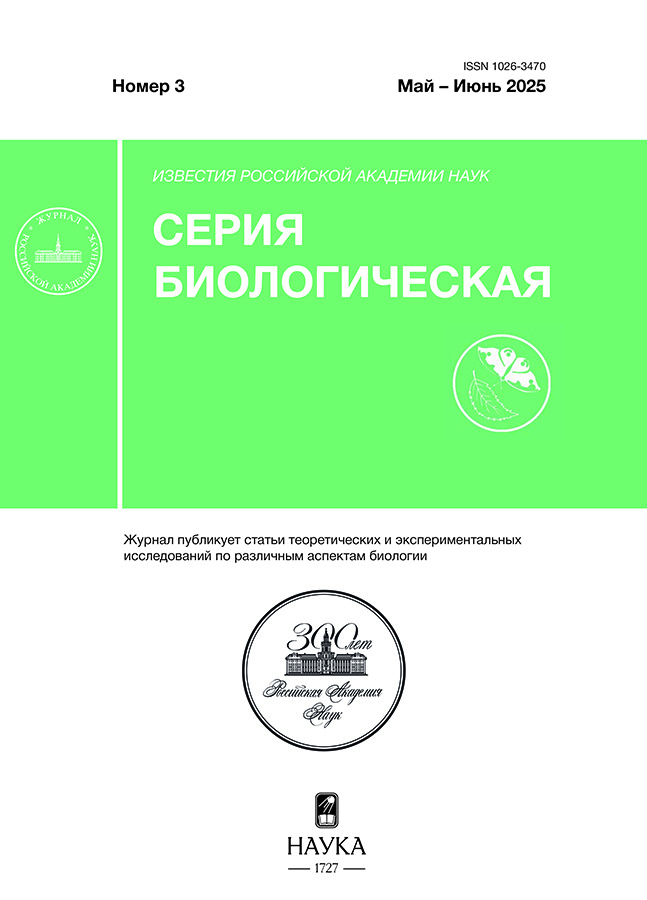Winter zooplankton of the Greenland and Barents Seas: a comparison of assemblages and assessment of environmental impact
- 作者: Dvoretsky V.G.1, Dvoretsky A.G.1
-
隶属关系:
- Murmansk Marine Biological Institute of the Russian Academy of Sciences
- 期: 编号 3 (2025)
- 页面: 317-327
- 栏目: ECOLOGY
- URL: https://gynecology.orscience.ru/1026-3470/article/view/686090
- DOI: https://doi.org/10.31857/S1026347025030076
- ID: 686090
如何引用文章
详细
Composition, diversity and distribution of zooplankton were studied in Fram Strait and in the southern Barents Sea during the winter period. Multivariate analysis revealed a clear separation of the sampling stations based on oceanographic, bathymetric, and food conditions. Two types of zooplankton assemblages were delineated and these corresponded to the two study regions. Copepods dominated by abundance and biomass. Generalized linear models showed a close relationship of the abundance of common zooplankton groups and diversity indices with mean water temperature, salinity, depth, and chlorophyll a concentration. An increase in the proportion of boreal species and in the total biomass suggested Atlantification of marine Arctic zooplankton communities as well as positive impact of warming on the zooplankton development.
关键词
全文:
作者简介
V. Dvoretsky
Murmansk Marine Biological Institute of the Russian Academy of Sciences
编辑信件的主要联系方式.
Email: v-dvoretsky@yandex.ru
俄罗斯联邦, 17 Vladimirskaya Str., Murmansk, 183038
A. Dvoretsky
Murmansk Marine Biological Institute of the Russian Academy of Sciences
Email: v-dvoretsky@yandex.ru
俄罗斯联邦, 17 Vladimirskaya Str., Murmansk, 183038
参考
- ГОСТ 17.1.4.02-90. ВОДА. Методика спектрофотометрического определения хлорофилла а // Государственный контроль качества воды. М.: Изд-во стандартов, 2001. С. 551–563.
- Дворецкий В. Г., Дворецкий А. Г. Экология зоопланктонных сообществ Баренцева моря и сопредельных вод. СПб.: Реноме, 2015. 736 с.
- Жизнь и условия ее существования в пелагиали Баренцева моря. Апатиты: Изд-во КФ АН СССР, 1985. 220 с.
- Зависимость между размерами и массой тела некоторых беспозвоночных и рыб Северо-Восточной Атлантики (справочно-информационный материал) / Сост. Е. Г. Берестовский [и др.]. Апатиты, 1989. 24 с.
- Инструкция по сбору и обработке планктона. М.: Изд-во ВНИРО, 1971. 82 с.
- Мэггаран Э. Экологическое разнообразие и его измерение. М.: Мир, 1992. 166 с.
- Тимофеев С. Ф. Экология морского зоопланктона. Мурманск: Изд-во МГПИ, 2000. 216 с.
- Численко Л. Л. Номограммы для определения веса водных организмов по размерам и форме тела. Л.: Наука, 1968. 106 с.
- Castellani C., Edwards M. Marine Plankton: A Practical Guide to Ecology, Methodology, and Taxonomy. Oxford: Oxford University Press, 2017, 704 p.
- Climatic atlas of the Arctic Seas 2004: Part I. Database of the Barents, Kara, Laptev, and White Seas – Oceanography and Marine Biology. NOAA Atlas NESDIS58. Washington: U. S. Government Printing Office, 2004. 148 p.
- Dvoretsky V. G., Dvoretsky A. G. Epiplankton in the Barents sea: Summer variations of mesozooplankton biomass, community structure and diversity // Cont. Shelf Res. 2013. V. 52. P. 1–11. https://doi.org/10.1016/j.csr.2012.10.017
- Dvoretsky V. G., Dvoretsky A. G. Early winter mesozooplankton of the coastal south-eastern Barents Sea // Estuar. Coast. Shelf Sci. 2015. V. 152. P. 116–123. ttps://doi.org/10.1016/j.ecss.2014.11.016
- Dvoretsky V. G., Dvoretsky A. G. Mesozooplankton in the Kola Transect (Barents Sea): Autumn and winter structure // J. Sea Res. 2018. V. 142. P. 125–131. ttps://doi.org/10.1016/j.seares.2018.09.022
- Dvoretsky V. G., Dvoretsky A. G. Arctic marine mesozooplankton at the beginning of the polar night: А case study for southern and south-western Svalbard waters // Polar Biol. 2020. V. 43. P. 71–79. https://doi.org/10.1007/s00300-019-02605-1
- Dvoretsky V. G., Vodopianova V. V., Bulavina A. S. Effects of climate change on chlorophyll a in the Barents Sea: А long-term assessment // Biology 2023. V. 12. Article 119. https://doi.org/10.3390/biology12010119
- Feng Z., Ji R., Ashjian C., Campbell R., Zhang J. Biogeographic responses of the copepod Calanus glacialis to a changing Arctic marine environment // Glob. Change Biol. 2018. V. 24, e159–e170. https://doi.org/10.1111/gcb.13890
- Hanssen H. Mesozooplankton of the Laptev Sea and the adjacent eastern Nansen Basin–distribution and community structure in late summer // Ber. Polarforsch. 1997. V. 229, P. 1–131.
- Hop H., Wiencke C. (eds.) The Ecosystem of Kongsfjorden, Svalbard. Cham: Springer, 2019. 596 p. https://doi.org/10.1007/978-3-319-46425-1_1
- Hurrell J. W., Kushnir Y., Ottersen G., Visbeck M. An overview of the North Atlantic oscillation. Geophysical Monograph-American Geophysical Union. 2003. Vol. 134. P. 1–36.
- ICES. Working Group on the Integrated Assessments of the Barents Sea (WGIBAR). ICES Sci. Rep. 2022. V. 4. 235 p.
- Jakobsen T., Ozhigin V. K. (Eds.). The Barents Sea: Ecosystem, resources, management: Half a century of Russian-Norwegian cooperation. Trondheim: Tapir Academic Press, 2011. 825 p.
- Legendre P., Legendre L. Numerical Ecology. Amsterdam: Elsevier Science, 1998. 852 p.
- Lewis K. M., Van Dijken G. L., Arrigo K. R. Changes in phytoplankton concentration now drive increased Arctic Ocean primary production // Science 2020. V. 369. P. 198–202. https://doi.org/10.1126/science.aay838
- Polyakov I. V., Alkire M. B., Bluhm B. A. et al. Borealization of the Arctic Ocean in response to anomalous advection from sub-arctic seas // Front. Mar. Sci. 2020. V. 7. Article 491. https://doi.org/10.3389/fmars.2020.00491
- Polyakov I. V., Ingvaldsen R. B., Pnyushkov A. V. et al. Fluctuating Atlantic inflows modulate Arctic atlantification // Science 2023. V. 381 (6661). P. 972–979. https://doi.org/10.1126/science.adh5158
- Raymont, J.E.G. Plankton and productivity of the Oceans. V. 2. Zooplankton. Oxford: Pergamon Press, 1983. 824 p.
- Richter C. Regional and seasonal variability in the vertical distribution of mesozooplankton in the Greenland Sea // Ber. Polarforsch. 1994. V. 154. P. 1–90.
- Rudels B. The Physical Oceanography of the Arctic Mediterranean Sea: Explorations, Observations, Interpretations. Amsterdam: Elsevier, 2021. 536 p.
- Sakshaug E., Johnsen G., Kovacs K. (Eds.). Ecosystem Barents Sea. Trondheim: Tapir Academic Press, 2009. 587 p.
补充文件












